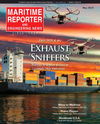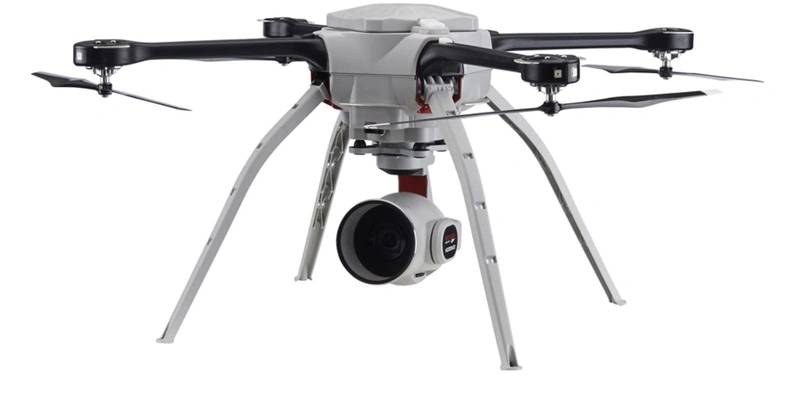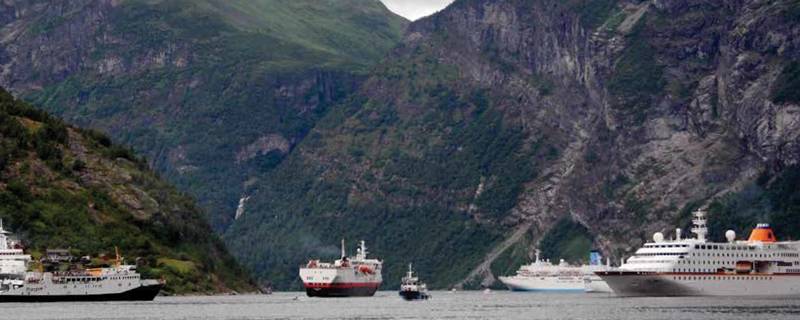
Norway Builds Drone Fleet for coastal “Sulfur Patrols”
Norway is growing its arsenal of military grade drones for missions that’ll take them into the exhaust streams of ship’s funnels. With the IMO now supporting the 0.1 percent sulfur cap on marine fuel from Jan. 2020, and with southern Norway below the 62nd parallel officially a European Emissions Control Area, or ECA, the Norwegian Maritime Authority, the NMA, is cracking down on illegal sulfur emissions.
Oslo’s NMA and its domestic enforcement allies — the Norwegian Coast Guard (Kystvakten), the Norwegian Coastal Administration and the police — will share the burden of making shipping to and from Norway compliant with EU, IMO and new Norwegian rules on emissions of sulfur, or rather sulfur-oxide. Checking for illegal levels of SOx is the job of NMA principal surveyor, Svein Erik Enge, who we meet in Haugesund, a sleepy town in Western Norway being transformed into Norway’s “clean-tech” cluster.
Enge in June of 2018 coordinated and supervised the NMA’s test drone project at the entrance to Bergen Harbor. For a week, a sensor-laden drone operated from the bridge of Kystvakten’s KV Tor was flown into the vapor stream of several ships to take samples of SOx. The exhaust’s electronic sulfur count was instantly transmitted to the KV Tor’s computer screens. Though the drone had kept its safe distance of 50 meters from the vessels, illegal levels of sulfur were detected. The Kystvakten contacted the NMA ashore, and a ship inspection was planned.
“We use it like a police breathalyzer test,” Enge says, adding, “But we still go onboard.” Still, the test inspections were a total success. The drone was “impressive.” It took five minutes for the drone to analyse samples using the leased chemical sensors it carried. The possibilities were endless: “You can notify the next port. You can issue a fee, or you can ask for a (fee payment) guarantee.” The highest fee issues to date has been to the tune of 650,000 kroner, or $75,000. It is understood to have gone to a cruise ship operator.
Since that fateful 2018 test, the Kystvakten has grown its fleet of drones from one to three and is reportedly ready to buy five new ones each year: or five sensors. The information we get from different sources seems contradictory. Enge says, “We only buy the sensors (not the drones),” while another source says the sensors are rented out from commercial players and Norway’s research institutes, like AMOS, who have developed their own “chemical-sniffing” spectral cameras.
 Complete sulfur-sniffer package: a NAS emissions inspection drone made from a modified Aeryon Labs R70 drone; below the original R70. Image: NAS/The Norwegian Coastal AdministrationZero-emissions
Complete sulfur-sniffer package: a NAS emissions inspection drone made from a modified Aeryon Labs R70 drone; below the original R70. Image: NAS/The Norwegian Coastal AdministrationZero-emissions
The Kystvakten was ideal for the job of inspection because it already had the vessels and could look after the drones. The coastal guard already inspects “50 to 100” ships each year inside the ECA, although that number is expected to rise sharply, and in 2018, ship inspections in all regions reached over 200. The IMO is now in on the sulfur cap, and from the beginning of 2026, Oslo begins enforcing a zero-emissions regime for cruise ships in the fjords. Until then, the IMO-recognized sulfur cap rules apply below 62 degrees North latitude, and after Jan. 1st, 2026, the area above will be subject to the sulfur cap. In 2030, the entire Norwegian littoral — an area as long as the West Coast of the United States — will be “emissions free.”
So, Enge and the Kystvakten’s new R-70 Sky Ranger drone are law enforcement pioneers at the dawn of a new low-emissions age. Like other trailblazers before them, they’ll build on existing experience. The Kystvakten is understood to have already used a Lockheed Martin Indago drone equipped with infra-red and 30x200 cameras to spot and chart oil spills during the day and at night. The new R-70s are from FLIR company Aeryon will also rely on fitted sulfur sensors, for now, while other sensors for other environmental elements are developed and procured in anticipation of further environmental tightening. “With IR for the first time, we could see how deep the oil was in the sea. You could locate the oil spill on a chart. It made it much, much easier,” Enge says. Now, ease was also being cited in that first sulfur inspection of a ship’s funnel exhaust: “You could see the drone lift off from the deck and follow the ship. It was better than a toy,” Enge says, an apparent reference to Aeryon’s vessel-tracker. Other stately first responders wanted one, too, so in 2018, five new R 70’s were ordered, their sensors unique to services that included the Norwegian Radiation Protection Authority; the Coastal Administration; the NMA and the Kystvakten.
In April 2019, Norse Asset Solutions, or NAS, delivered the Sky Rangers’ sulfur sensors and GIS, and the drones with sniffers became a 14 million kroner contract in March 2019. Canadian company Aeryon Labs (owned and now called Oregon-based FLIR) built the drones and supplied Aeryon Mission Control Systems originally made for the military market. The R-70’s are man-portable at 80 centimeters wide; fly at speeds of up to 50 km/h for 50 minutes to five km away. They can handle 70 km/h winds and, during sulfur inspections, will “ideally” be followed by a support craft, autonomous or not.
But as with all drones, it’s payload, payload, payload. The 2.5 kilogram drone can carry a 2.5 kg camera and sensor payload. The NAS sulfur sniffer is tiny, but only needs to suck in a miniscule air sample to replicate the analysis trained surveyors have always done in NMA labs.
“We can change out the sensor, and you can check for other gaseous elements as well,” said Enge, who admits, “We’re still working on the software for this one.” Indeed, the new drones the NMA will procure come with Aeryon Labs secure Application Development Kit and Payload Development Kit “to enable rapid third-party software integrations and payload developments”, and that’s exactly what happened.
When the Sky Ranger was introduced in 2015, TrellisWare Technologies, Datron, Aeryon Labs and Black Diamond Advanced Technologies reportedly presented the SkyRanger to the US Marine Corp with a TSM radio that enabled real-time streaming and thermal imaging over a mobile ad-hoc network, or MANET. It’s not known whether any of this technology is being used in Norway. Problem: cruise ships emitting exhaust in “crowded” Norwegian fjords. Image: NMASuper drones
Problem: cruise ships emitting exhaust in “crowded” Norwegian fjords. Image: NMASuper drones
Drone sales for maritime applications have been a big hit in Norway, although structure integrity missions have been the main draw. Since 2015, Stavanger-area outfit, Nordic Unmanned, struck a distribution deal with Lockheed Martin for their Indago VTOL drones.
Since then, Nordic Unmanned has earned contracts pulling hydro power pilot lines and dropping objects for electric grid operators as well as surveys for the national railroad. Kongsberg Maritime Broadband Radio, a satellite-independent system, is at least aboard the Indago drones, one of two types tested, since a deal exists between Nordic Unmanned and Kongsberg. The MBR also streams real-time surveillance video in real-time between ground, air and marine assets.
The new NMA orders of Sky Ranger drones are understood to be R70’s that can operate from -30 degrees Celsius to 50 Co. They’re intuitive enough that the surveyor need not be an engineer, although they will receive training from NAS and, or Nordic Unmanned and FLIR.
“This drone is the first of its kind that’s being combined and integrated as a finished package,” NAS operations leader, Joachim Hovland, was quoted by stately chroniclers as saying. “Before this, we did not have the opportunity to inspect vessels that are sailing, but now we’re the first in the world to systematically use drones for this type of work. The drone will therefore ensure that we make more effective the way we inspect sulfur emissions from vessels.”
One thing is certain: Enge was “extremely pleased” with the navigation and flight control of the Sky Rangers from the KV Tor’s deck, with its camera controls. “The touch screen system allows the execution of dynamic flight plans,” a manufacturer’s note says. And Enge and the NMA will also use a point-and-click XRF pistol that scans fuel and can determine sulfur content within 30 seconds — or about as long as the Sky Ranger has to remain in the exhaust stream of a ship’s funnel.
Read Norway Builds Drone Fleet for coastal “Sulfur Patrols” in Pdf, Flash or Html5 edition of May 2019 Maritime Reporter
Other stories from May 2019 issue
Content
- AIS Data: History & Future page: 10
- Digitalization: Managing the Flow page: 12
- Offshore Wind: California's New Gold Rush page: 16
- Interview: Dirk Balthasar, President, Thermamax page: 26
- Norway Builds Drone Fleet for coastal “Sulfur Patrols” page: 28
- Marine Fuel: World First for Megaboxer MV Sajir page: 32
- Interview: Dan Skjeldam, CEO, Hurtigruten page: 36
- Interview: Kjeld Aabo, Director New Technologies, MAN ES page: 44
- Interview: Edmonds Brown, Cummins, Inc. page: 46
- Workboat Report: The U.S. Workboat ($33.8B) Market page: 52
- Marine Autonomy Put to the Test page: 64
- Tech File: Sea Skipper Fire & Salvage Pump page: 71


